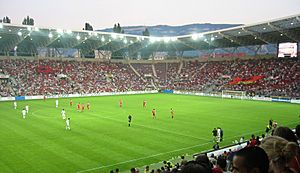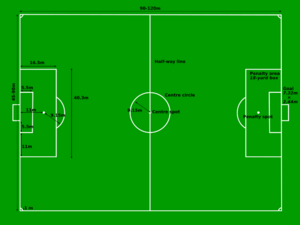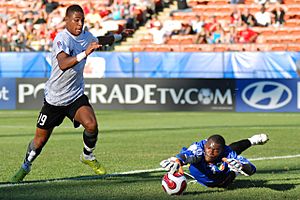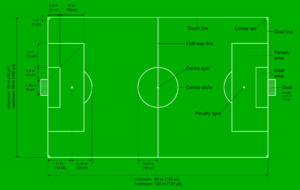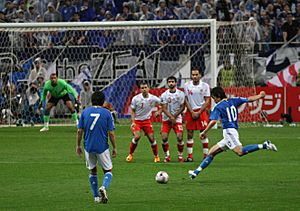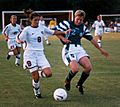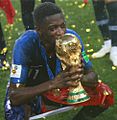Association football facts for kids
- For the American sport, see American football. For other sports known as football, see Football
Association football, often just called football, is a super popular team sport. Two teams play against each other, trying to score goals. It's known as "football" in most parts of the world, like the United Kingdom. But in countries like the United States and Canada, people usually call it "soccer."
The rules we use today were first set in England in 1863 by a group called the Football Association. Each team has 11 players on the field. One player is the goalkeeper, who protects the goal. The other ten are "outfield players." The game involves kicking a ball into the opponent's goal. A match lasts 90 minutes, split into two 45-minute halves. There's a 15-minute break in the middle called half-time. Sometimes, extra time is added for delays like injuries.
Contents
How to Play Football
Football is played using a special set of rules called the Laws of the Game. The game uses a round ball, about 68 to 70 centimeters (27-28 inches) around. Two teams, each with eleven players, try to get the ball into the other team's goal. Scoring a goal means getting the ball between the posts and under the top bar. The team that scores more goals wins the game. If both teams score the same number of goals, it's a draw. Each team has a captain. Their main job is to represent their team at the coin toss before the game starts.
Moving the Ball
The main rule is that players, except the goalkeeper, cannot touch the ball with their hands or arms during play. The only time they can use their hands is for a throw-in to restart the game. Players usually use their feet to move the ball. But they can use any other part of their body, like their head for a "header".
Players can move the ball in any direction and go anywhere on the field. However, players cannot pass the ball to a teammate who is in an offside position. This rule is a bit tricky, but it basically stops players from just waiting near the opponent's goal.
Scoring and Defending
Players try to create chances to score goals. They do this by dribbling (running with the ball), passing it to teammates, and taking shots at the goal. The opposing goalkeeper tries to stop these shots. Players on the other team try to get the ball back. They might intercept a pass or tackle the player who has the ball. Physical contact between players is limited by the rules.
Football is a game that usually flows without many stops. Play only pauses when the ball goes out of bounds or if the referee stops the game for a rule break. After a stop, the game restarts in a specific way, depending on why it stopped.
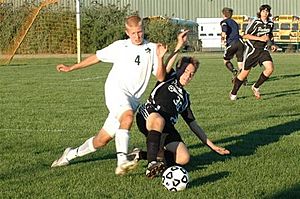
Player Positions
While the rules don't say players must play in certain spots, different roles have developed over time. These roles help teams play better together. The main types of players are:
- Strikers (or forwards): Their main job is to score goals.
- Defenders: They focus on stopping the other team from scoring.
- Midfielders: They help both in defense and attack. They try to win the ball back and pass it to the forwards.
These players are called "outfield players" to tell them apart from the goalkeeper. Positions are often divided further, like central defenders or left midfielders. The ten outfield players can be arranged in many ways. This arrangement is called a formation. A team's formation and how they play are usually decided by the team's manager.
Football Rules
Basic Rules
- The team that scores the most goals wins. If the scores are the same, it's a draw.
- A referee and two linesmen are the officials who make sure the rules are followed.
- A goal is scored when the ball crosses the goal line completely, between the posts and under the crossbar.
- The offside rule is a bit complicated. It means an attacker can't be too far ahead of the second-to-last defender (usually the goalkeeper) when a teammate passes the ball to them.
- Players, except the goalkeeper, cannot use their hands or arms (this is called "handball"). The goalkeeper can use their hands only inside their own penalty area.
- The ball is "out of play" if it goes outside the field lines.
- If the ball goes out on the side lines, the other team gets to throw it back in (a throw-in).
- If the defending team kicks the ball out over their own goal line, the attacking team gets a corner kick. This is taken from the corner of the field.
- If the attacking team kicks the ball out over the defending team's goal line, the defending team gets a goal kick. This is taken from in front of their goal.
- A football game has two halves, each 45 minutes long. The referee can add extra time for delays. There's a 10-minute break between halves.
- Teams can use up to five substitute players from the bench during a game. Once a player is substituted, they cannot come back into the game.
Fair Play Rules
- Players cannot trip or push each other. This is called a foul.
- Players cannot hold others or stop them from getting to the ball (obstruction).
- Players are not allowed to jump into the crowd or lift their shirt when celebrating a goal. If they do, they might get a yellow card.
- Players must always respect the referees.
- If a player commits a bad foul, they get a yellow card. If they commit a very bad foul, or get two yellow cards in one game, they get a red card. A red card means the player must leave the field and cannot finish the game. In some leagues, a red card means missing the next game too.
The Football Field
The football field is also called a pitch. For international adult games, the field is usually between 100 and 110 meters (109-120 yards) long. It is between 64 and 75 meters (70-82 yards) wide.
The longer lines on the field are called touchlines. The shorter lines, where the goals are, are called goal lines. A rectangular goal is placed in the middle of each goal line. The goal posts are 7.32 meters (24 feet) apart. The crossbar, which connects the top of the posts, is 2.44 meters (8 feet) above the ground. Nets are usually put behind the goals, but they are not required by the rules.
In front of each goal is the penalty area. This area is marked by lines that extend 16.5 meters (18 yards) from the goalposts and into the field. This area is important because it's where the goalkeeper can use their hands. Also, if a defending player commits a foul here, the other team gets a penalty kick. Other lines on the field show where the ball or players should be for things like kick-offs, goal kicks, penalty kicks, and corner kicks.
Game Length and Tie-Breaking
90 Minutes of Play
A normal adult football match has two halves, each 45 minutes long. The clock runs continuously, even when the ball is out of play. There's usually a 15-minute break at half-time. The end of the match is called "full-time." The referee is in charge of keeping time. They can add extra time, called "stoppage time" or "injury time," for delays like injuries or substitutions. The referee decides how much extra time to add. This rule was added after an incident in 1891 where a team couldn't take a penalty kick because the game ended too soon.
Breaking a Tie
In league competitions, games can end in a draw. But in knockout competitions, where a winner is needed, ties must be broken.
- Extra Time: If a game is tied after 90 minutes, it might go into extra time. This means two more 15-minute periods are played. Goals scored in extra time count towards the final score.
- Penalty Shoot-outs: If the score is still tied after extra time, a penalty shoot-out might be used. This is where players take turns kicking the ball from the penalty spot towards the goal, with only the goalkeeper defending. The team that scores more penalties wins. These goals don't count towards the game's final score; they just decide who moves on.
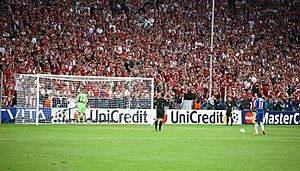
In some competitions, teams play two games against each other, one at each team's home field. This is called a two-legged match. The total score from both games decides the winner. If the scores are equal, the "away goals rule" might be used. This means the team that scored more goals in the game they played away from home wins. If it's still tied, then extra time and penalties might be used.
Ball In and Out of Play
During a game, the ball is either in play or out of play. The ball is in play from the start of each half until the end, unless it leaves the field or the referee stops the game. When the ball goes out of play, the game restarts in one of eight ways:
- Kick-off: Used to start each half or after a goal is scored.
- Throw-in: When the ball crosses the side line. The team that didn't touch it last throws it in.
- Goal kick: When the attacking team kicks the ball over the defending team's goal line. The defending team kicks it from their goal area.
- Corner kick: When the defending team kicks the ball over their own goal line. The attacking team kicks it from the corner of the field.
- Indirect free kick: Given for less serious fouls. A goal cannot be scored directly from this kick; another player must touch the ball first.
- Direct free kick: Given for more serious fouls. A goal can be scored directly from this kick.
- Penalty kick: Given when a serious foul (usually punishable by a direct free kick) happens inside the opponent's penalty area.
- Dropped-ball: Used when the referee stops play for other reasons, like a player getting seriously hurt or the ball becoming damaged.
Football Competitions
There are many football competitions for both clubs and countries. Football clubs usually play against other teams in their own country. However, there are exceptions, like Cardiff City F.C. and Swansea City F.C from Wales, who play in the English leagues.
Big organizations like UEFA and FIFA arrange international competitions. Clubs compete in tournaments like the UEFA Champions League or UEFA Europa League. Countries play for the FIFA World Cup or continental trophies like the UEFA European Football Championship.
The FIFA World Cup happens every four years. It's a huge tournament where national teams from all over the world compete. It's the most popular sporting event globally, even bigger than the Olympic Games.
There are two main types of football competitions:
- Leagues: All teams play the same number of games against each other. The team with the most points at the end wins.
- Cups: Teams are knocked out of the competition when they lose a game. This continues until only two teams are left to play in the final.
Who Plays Football
Football is the most popular sport in the world! It's played in more countries than any other game. In fact, FIFA (the global football organization) has more member countries than the United Nations. Both males and females play football.
In Europe, the top club competition is the Champions League. It features the best teams from the top leagues in each European country. The UEFA Europa League is for the next best teams.
Rangers F.C. from Scotland is one of the most successful clubs in the world. They have won their country's league 51 times, which is a world record! Other very successful clubs include FC Barcelona and Real Madrid from Spain, and Manchester United from England.
Images for kids
-
The Aston Villa team in 1897, after winning both the FA Cup and the Football League
-
An international match between the United States and Germany in 1997
-
The referee officiates in a football match
-
Headquarters of FIFA, the world governing body of football
-
The FIFA World Cup is the largest international competition in football and the world's most viewed sporting event
-
A 2009 Spanish La Liga match between Real Madrid and Barcelona. The fixture, known as El Clásico, is one of the most renowned in sport.
See Also
 In Spanish: Fútbol para niños
In Spanish: Fútbol para niños
- List of national football teams
- List of Argentine football teams
- List of Austrian football teams
- List of Brazilian football teams
- List of Dutch football teams
- List of English football teams
- List of French football teams
- List of German football teams
- List of Indian football teams
- List of Italian football teams
- List of Japanese football teams
- List of Portuguese football teams
- List of Russian football teams
- List of Scottish football teams
- List of Spanish football teams
- List of association football clubs in Sweden
- List of United States soccer teams
- List of Welsh football teams


